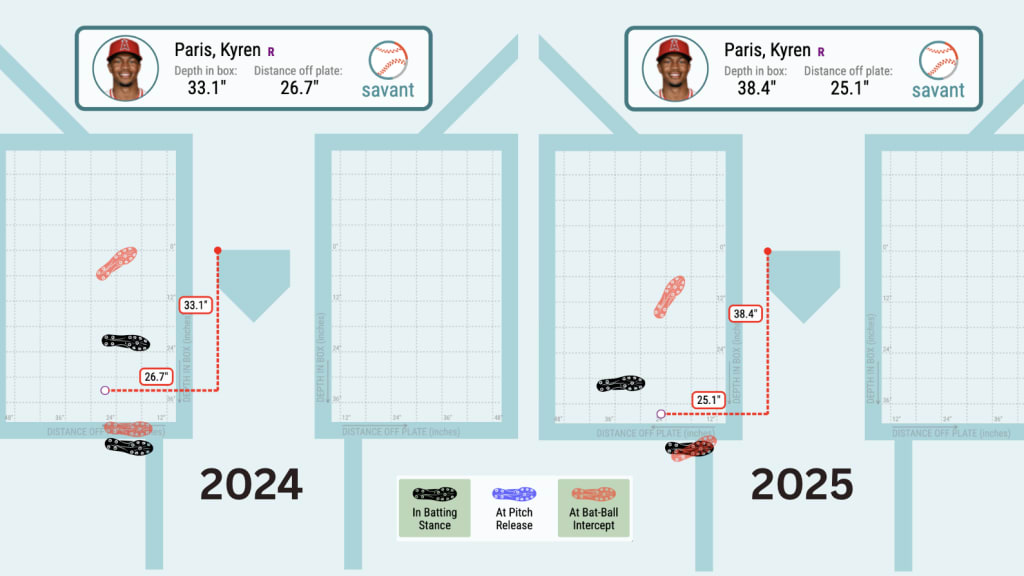There¡¯s an Angel at the top of the Wins Above Replacement leaderboard, but it might not be the player you expect.
Doing his best Mike Trout impression -- or is it actually an Aaron Judge impression? More on that below -- Kyren Paris has taken baseball by storm, hitting an absurd .368/.467/.842 with five home runs and five stolen bases in his first 14 games. His 1.3 WAR (FanGraphs) is third among position players, trailing only Corbin Carroll and Aaron Judge.
Paris' start to the season was historic in many ways. He became just the third player in the expansion era (since 1961) to record at least 11 hits, five home runs, four stolen bases and four walks in their first 10 games of the season, joining Larry Walker (1997) and Gary Redus (1983). His 1.653 OPS through 10 games (min. 30 PA) was also the second-best in MLB history, trailing only Jimmie Foxx¡¯s 1.731 mark in 1928.
While it¡¯d be easy to dismiss what Paris is doing in a small sample, there are real changes that the 23-year-old has made that have potentially given the Angels a legitimate everyday big leaguer.
The following numbers are through Sunday's games.
Swing changes
Drafted No. 55 overall by the Angels in 2019, Paris slowly rose through the Angels system and became one of the organization¡¯s top prospects -- MLB Pipeline ranked him as the club¡¯s No. 4 prospect in 2022 and ¡®24.
Paris debuted in 2023 and struggled mightily throughout his first two MLB seasons. Among hitters who received at least 100 plate appearances from 2023-24, Paris¡¯ .378 OPS was the second-worst in the Majors. The youngster also dealt with injuries in 2024 that limited him to just 70 games between the Majors and Minors. Even when he was healthy last year, Paris struggled in both the Majors and Minors. In a 23-game stint with Double-A Rocket City last year, Paris had just seven hits in 77 at-bats (.091 BA) and a .328 OPS.
That sparked drastic changes last offseason. In a recent newsletter, MLB.com¡¯s Angels beat writer Rhett Bollinger detailed how Paris sought Judge¡¯s hitting coach Richard Schenck, who has worked with the Yankees slugger since the 2016-17 offseason. Paris told Bollinger that he worked together for three days near Schenck¡¯s home outside of St. Louis over the offseason, which ¡°totally changed Paris¡¯ mechanics."
¡°I worked with Aaron Judge¡¯s hitting coach and there are a lot of similarities in my swing now, but it's helped me a lot,¡± Paris told Bollinger. ¡°It¡¯s more like a hover [with my foot] and the finish is similar as well.¡±
While it¡¯s far-fetched to think that Paris will follow in Judge¡¯s footsteps as one of his generation¡¯s top hitters, you can see the similarities in the swing.
¡°Paris has allowed the ball to travel deeper because of the changes in his swing and the way he shifts his weight, which gives him more time to react to pitches,¡± Bollinger said.
Take a look at how much his swing has changed in the span of a season.
You can see what Paris is talking about when he says he's able to stay back longer and give himself more time to see the pitch. There's also an undeniable difference in how much energy and power his new swing is producing.
Changing it up in the box
Paris¡¯ changes go much further than just the swing.
Statcast¡¯s latest release tracks batting stances, looking at a hitter¡¯s depth in the box, the distance between feet, stance angle and intercept (or contact) point. Whereas we couldn¡¯t objectively measure these changes in the past, we can now see that Paris has completely revamped his placement in the box and his stance angle.

No player with at least 25 swings this season is standing further back in the box than Paris, who is at a whopping 38.4 inches behind the front of home plate. The next-closest hitter is J.P. Crawford, who is nearly three inches forward at 35.5 inches.
You¡¯ll also notice the drastic change in his stance angle. Whereas he was open at a 3-degree angle last season, he's at 53 degrees this year, which is only behind Red Sox¡¯ slugger Rafael Devers (63 degrees).

Naturally, Paris is connecting with the baseball further in the zone than any player in the Majors. Paris¡¯ intercept point -- the average point at which a hitter's bat is nearest to the baseball on a swing -- is a whopping 13.3 inches behind the front of the plate. The next-closest player is Kerry Carpenter at 8.8 inches.
Paris¡¯ placement in the box is interconnected with what Bollinger detailed in his newsletter. By placing himself further back in the box and utilizing his new swing changes, Paris is allowing the ball to get as deep as possible and giving himself more time to read the pitch.
Doing damage
Paris hasn¡¯t faked his hot start -- he¡¯s legitimately crushing baseballs with the best of them so far.
Based on expected wOBA -- which looks at a player¡¯s quality and quantity of contact -- Paris¡¯ .428 mark is 17th among qualifying hitters. Paris has also barreled 17.9 percent of his batted balls, which ranks 27th and has him sandwiched between Trout and Kyle Tucker.
This kind of contact quality is a stark difference from what he showed in his first two years.
2023-24 (36 games) vs. 2025 (14 games)
xwOBA: .251 vs. .428
Barrel rate: 5.2% vs. 17.9%
Hard-hit rate: 34.5% vs. 60.7%
Launch angle: 5.0 degrees vs. 11.3 degrees
Bat speed: 72.2 mph vs. 73.8 mph
Squared-up rate: 26.4% vs. 45.5%
Blast rate: 12.3% vs. 30.3%
After producing just three barrels (58 batted balls) in his first two seasons, he¡¯s already barreled five of 28 batted balls this season. That¡¯s backed up by his bat tracking numbers, showing a drastic improvement in his squared-up and blast rate thanks to a 1.6 mph increase in bat speed.
Paris has been especially powerful against fastballs, slugging four of his five home runs against four-seamers this season. In 23 plate appearances ending in fastballs, Paris is slugging 1.091, the second-best mark in baseball (minimum 20 plate appearances). He¡¯s also slugging .571 in 17 plate appearances ending on breaking balls, including a homer and triple against the slider.
If there¡¯s one cause for concern, it¡¯s Paris¡¯ propensity to swing through pitches. His 41.1 percent whiff rate ranks in the 2nd percentile and is a sizable increase from his 33.3 percent rate in 2023-24. He¡¯s also expanded the zone more frequently, chasing on 30.3 percent of pitches compared to 22.1 percent the previous two seasons.
Still, Paris¡¯ chase rate is roughly league average and he¡¯s walking in a healthy 10.9 percent of his plate appearances. A high whiff rate also won¡¯t necessarily stop Paris from mashing -- plenty of powerful hitters have managed to slug and whiff at elevated clips. Sluggers like Shohei Ohtani, Aaron Judge, Kyle Schwarber and Rafael Devers all whiffed around 30 percent of the time in 2024 and managed to crush a bunch of homers anyway. If Paris can get his whiff rate back around his 2023-24 level, it¡¯ll be much more manageable.
We haven¡¯t even touched on Paris¡¯ speed and defense. His 29.0 feet-per-second sprint speed places him in the 95th percentile and has helped lead to five steals already this year. He¡¯s used that speed to profile as a competent option in both center field and at second base for the Angels.
It¡¯s far too early to make any definitive proclamation that Paris is a budding star in the Majors. Pitchers will have their turn to counterbalance Paris and it¡¯s up to the youngster to make the necessary adjustments. What is clear, though, is that Paris looks like a completely different player and is a key reason why the Angels are off to a 9-6 start.
